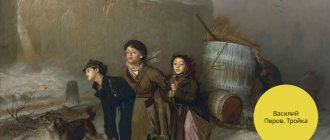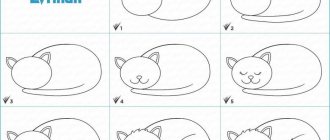Notes and presentation for the class hour “Rights and Responsibilities of the Child”; 2nd grade
Primary school teacher
MBOU "Lyceum No. 81" of Novosibirsk
Bochkar Marina Sergeevna
Goal: to introduce children to the “Constitution” of Russia, the “Convention on the Rights of the Child”, and the universal “Declaration of Human Rights”.
Objectives: to help children understand the concepts of “rights” and “responsibilities”;
generalize children's knowledge about the basic rights of the child; contribute to the development of children's motivation to use legal knowledge in life.
to form a respectful attitude towards each other, to instill in students a sense of civic responsibility
Equipment: Dictionary S.I. Ozhegova, puzzles, cards with key words, exhibition of drawings, presentation.
Progress of the lesson
1. Organizational moment.
2. Announcing the topic and setting the goal of the lesson:
Today we will try to figure out where in everyday life we exercise our rights, duties and bear responsibility.
A long time ago, thousands of years ago, people appeared on Earth. At the same time, the main questions appeared:
What can people do and what can't they do?
What are they obligated to do and what are they not obligated to do?
What are they entitled to and what are they not entitled to?
And so on.
Without a clear answer to these questions, life turned into a complete nightmare and confusion.
In the end, people managed to solve the Essential Questions, and the Universal Declaration of Human Rights was born. Over time, people realized that the child needed special protection and care.
Declaration of the Rights of the Child.
In 1959, the UN General Assembly proclaimed the Declaration of the Rights of the Child.
It argues that some human rights are directly relevant to children, who need special care and attention. Its content was a call for goodness and justice for children. However, declarations are only advisory in nature; their norms are not binding.
Another thing is the convention
; it is a treaty that must be strictly implemented by those who sign it. On November 20, 1989, the Convention on the Rights of the Child was unanimously adopted by the UN General Assembly. It is designed to create favorable conditions for the development of children.
In our state, as in any other, there is a basic law
by which we live.
- What is the name of this law?
The laws that regulate relations between the state and society are written in the Constitution
- the fundamental law of the state. (Demonstration of the book.)
3.Work in groups
— Remember what rights are guaranteed to you by the state?
4. Discussion of illustrations for fairy tales (ON SLIDES)
Many literary works, one way or another, touch upon Human rights. Let's remember these works...
5. Responsibilities. Analysis of situations. Situations play out.
Ira: Nastya, you are on duty today, please stay and wash the board and water the flowers.
Nastya: Ira, you have no right! The Convention prohibits child labor.
Who is right?
Vanya: Dima, you’re not ready for reading on Monday!
Dima: Yesterday was Sunday. I have every right to rest.
Who is right?
Conclusion. While protecting your rights, you must not forget about your responsibilities.
6. REFLECTION
- We talked about the rights, duties and responsibilities of children. I offer you situations from your life. If you answer the questions honestly, you will understand whether you are doing everything right, or whether you still need to work on yourself.
Situation 1 – You have been assigned to design a New Year’s newspaper:
a) I’ll put everything aside and get on with the paperwork b) I’ll do it when I have free time c) I’ll delegate it to another classmate
Situation 2 – You are sitting in transport. An elderly woman comes in:
a) I’ll give up my seat b) I’ll ask my neighbor to give up my seat c) I’ll turn away and look out the window
Situation 3 – You see your classmate being beaten:
a) I’ll try to protect b) I’ll ask passers-by to intervene c) I’ll pass by
Situation 4 – You found a wallet containing 100 rubles:
a) I’ll try to return it to the owner b) I’ll give it to an adult c) I’ll take it for myself
Answer a) – 5 points; b) – 3 points; c) – 0 points.
If you score between 15 and 20 points, you’re doing great! Continue to act with the same confidence. Your parents and school can be proud of you.
If from 10 to 15 points, you have something to work on.
If less than 10 points, there is nothing left to do but pull yourself together and work hard on yourself.
7. Summary
Both adults and children have rights.
But we should not forget that in addition to rights, everyone also has responsibilities to society.
When defending your rights, do not forget that other people also have the same rights as yours.
Respect other people's rights!
Conversation “Children's Rights”
SOGBOU "Vyazemsk school - boarding school for children with disabilities"
"Child's rights"
Educator: Golyshevskaya L.V.
Child's rights
Goal: To summarize children’s knowledge about the basic rights of the child.
Objectives: Show the unity of rights and responsibilities, cultivate respect for classmates, adults, and their rights.
Progress of the conversation
Vospi-l:
How do you understand the last sentence? A child has rights from birth. So you say: he has the right to this and that. What is right? “Law is a set of norms and rules established and protected by the state authorities that regulate relations between people.”
Guys, what do you think is the topic of our lesson? We will talk about children's rights. Listen to how beautifully and vividly it is said. "Law exists for the benefit of humanity." “Law is the art of goodness and justice.” What rights do you already know?
A long time ago, thousands of years ago, people appeared on Earth. At the same time, questions arose;
What can a person do and what cannot he do?
What is a person obligated to do and what is he not obligated to do? What does a person have a right to and what does not a person have a right to? And today, using examples from fairy tales, we will find out what a child has the right to?
We are back to our original tale. You must know what rights you have. But do not forget that your mothers and fathers, teachers and educators, classmates and acquaintances have rights. Now I will give you cards. Do you need to consider the situation, discuss, find out whether the child’s rights have been violated? If so, which ones?
1 The child was forced to do his homework. It's your responsibility to learn. Parents take care of the child, so his rights are not violated.
2 Mom asks her son to go to the store. He came home from school and said that he was tired, had the right to rest and refused to go.
The mother asked her son not to show any cruelty towards him. You need to remember your responsibilities. No rights have been violated.
3 The child was forced to clean his room.
The child must know his responsibilities. In this situation, he was asked to clean up his room, after himself.
4 The child was forced to wash his hands before eating.
The rights of the child have not been violated. Parents care about the child's health. You must follow the rules of hygiene.
Are rights the only ones that play a role in our lives? Not only rights, but also responsibilities play a role in our lives. What responsibilities do you know? Responsibility to study well, help at home, care for the elderly.
Comrades adults and children
We are all responsible for our future
Know your rights and responsibilities
Grow up to be good people!






